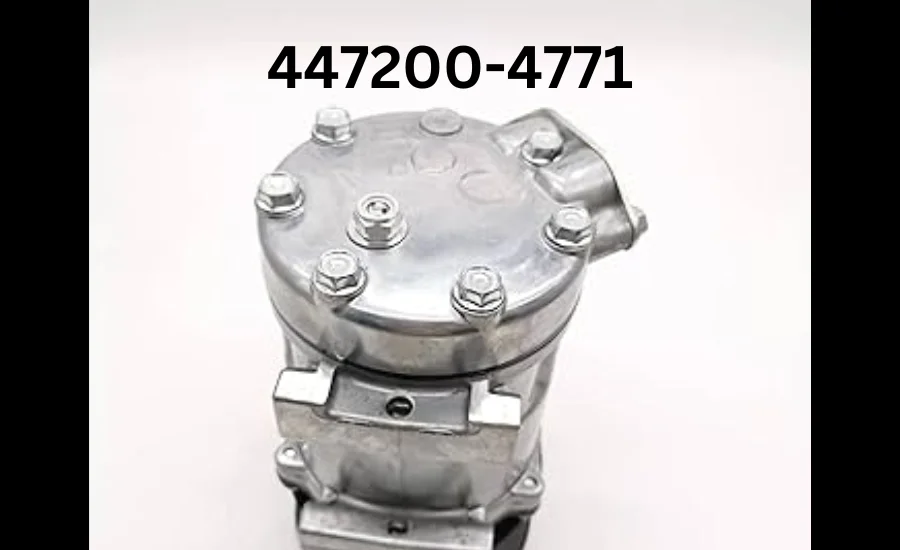Introduction to 447200-4771
The code “447200-4771” likely refers to a specific part number or product identification used in various technical sectors. Part numbers like these help streamline the supply chain, ensuring that components can be identified and used efficiently in production or maintenance. These codes often contain crucial information about the product, such as its model, type, material, and application.
Understanding what “447200-4771” represents is essential in contexts where precision, compatibility, and efficiency are critical. These kinds of identifiers are common in sectors such as automotive, aerospace, industrial machinery, and electronics, where specific parts need to meet rigorous standards.
The Role of Part Numbers in Manufacturing
In any manufacturing process, part numbers like “447200-4771” play a critical role. Part numbers are essential for:
- Identification: Allowing manufacturers and end-users to quickly identify and source specific components.
- Consistency: Ensuring that each part produced meets the same specifications, quality, and standards.
- Supply Chain Management: Streamlining the ordering process, making it easier to track, purchase, and replace components.
- Maintenance: Helping technicians find the right parts for repair or replacement.
- Record Keeping: Assisting with inventory management and tracking throughout the product lifecycle.
Part numbers like 447200-4771 typically adhere to a standardized format, which can vary depending on the industry or manufacturer. These codes ensure that manufacturers, engineers, and technicians can find and use the correct component in a highly specific context.
Importance of Accurate Identification in Engineering
Accuracy in part identification is vital in engineering, as even a small error can lead to system malfunctions, safety hazards, and financial losses. Codes like “447200-4771” ensure:
- Precision: Engineers need precise components to maintain operational efficiency, safety, and durability.
- Interchangeability: Part numbers make it easy to swap components in case of a malfunction or upgrade, reducing downtime in industrial settings.
- Quality Control: Manufacturers can quickly identify faulty parts, manage recalls, and replace them without halting production.
In fields like aerospace or automotive manufacturing, accurate identification through part numbers is non-negotiable. The risk of using incorrect components can have severe consequences, making the use of standardized codes a critical safety measure.
Potential Applications of 447200-4771
While we don’t have specific details about the exact nature of “447200-4771,” it likely falls into one of the following categories based on the structure of similar part numbers:
A. Automotive Industry
The code “447200-4771” could be part of an automotive system, perhaps as a specific engine component, brake part, or electronic control module. The automotive industry relies on a vast network of parts, and each has its own unique identifier for easy assembly, maintenance, and replacement.
Key automotive applications may include:
- Engine Components: Such as gaskets, seals, or pumps.
- Transmission Systems: Gears, clutches, or belts.
- Braking Systems: Calipers, discs, or hydraulic lines.
- Electronic Control Modules (ECMs): For managing engine or brake functions.
B. Industrial Machinery
In industrial machinery, the part number “447200-4771” may refer to a component within heavy-duty equipment like compressors, turbines, or hydraulic systems. The machinery in industries such as construction, mining, and manufacturing demands high-performance components that must be correctly identified and sourced.
Potential applications could include:
- Pumps and Valves: Used in hydraulic or pneumatic systems.
- Bearings and Gears: Vital for smooth operation in industrial equipment.
- Seals and Gaskets: For preventing leaks in pressurized systems.
C. Aerospace Components
In the aerospace sector, part numbers are particularly critical. Components used in aircraft systems must meet the highest safety and performance standards. The part number “447200-4771” may correspond to a piece of aerospace equipment, whether mechanical or electronic, used in an aircraft’s control system, fuel system, or navigation apparatus.
Examples might include:
- Fuel System Components: Such as pumps or regulators.
- Avionics Systems: Circuit boards or sensors.
- Control Surfaces: Components that help in flight maneuvering.
D. Electronics and Circuitry
Alternatively, “447200-4771” might belong to the electronics sector. Components in this field are often highly specialized, with part numbers assigned to resistors, capacitors, semiconductors, or circuit boards. Electronics manufacturing depends on precise identification for ensuring that each component fits into larger systems.
Potential uses may include:
- Printed Circuit Boards (PCBs): Components used in electronic devices, from consumer electronics to industrial machines.
- Microchips or Semiconductors: Used in various computing or telecommunication systems.
- Capacitors and Resistors: Critical for managing electrical currents in complex circuits.
Understanding the Manufacturing Process of Components like 447200-4771
Components with part numbers such as “447200-4771” are typically produced through intricate manufacturing processes. These processes may include:
- Design and Prototyping: Engineers design the part based on specific functional and environmental requirements. Prototypes are then created to test the design.
- Material Selection: Choosing the right materials is crucial to the part’s durability, performance, and safety. Materials may range from metals like aluminum and steel to plastics, composites, or ceramics.
- Manufacturing Techniques: Methods such as casting, forging, machining, or 3D printing are employed to produce parts with high precision. Advanced technology like CNC (Computer Numerical Control) machining ensures accuracy.
- Quality Control and Testing: Before a component is approved for use, it must undergo rigorous testing to ensure it meets all required standards. This may involve stress testing, thermal testing, and material inspections.
Common Materials Used in Production
The type of material used to manufacture components like “447200-4771” depends on the part’s application and the demands it will face during operation. Common materials include:
- Steel and Stainless Steel: Known for their strength and resistance to corrosion, steel components are commonly used in heavy machinery and automotive systems.
- Aluminum: Lighter than steel, aluminum is often used in aerospace and automotive industries to reduce weight without sacrificing durability.
- Plastics and Composites: These materials are used for their lightweight and versatile properties, especially in electronics and consumer goods.
- Ceramics: High-temperature resistance makes ceramics ideal for use in environments exposed to extreme heat, such as engine components or industrial kilns.
Performance Evaluation and Testing Procedures
Before components like “447200-4771” are approved for industrial use, they undergo a variety of tests to ensure performance standards. These include:
- Mechanical Testing: To determine the component’s strength, durability, and resistance to wear under operational conditions.
- Thermal Testing: To evaluate the part’s ability to withstand extreme temperatures, especially in industries like aerospace or automotive.
- Electrical Testing: For electronic parts, testing ensures that electrical resistance, conductivity, and insulation properties are within the required specifications.
- Safety Standards Compliance: In industries such as aerospace, automotive, and healthcare, parts must meet stringent safety regulations, which involve rigorous testing for both performance and safety.
Importance of Maintenance and Proper Handling
For components like “447200-4771” to function effectively over time, proper maintenance is essential. Regular inspection, cleaning, and replacement of worn parts can extend the life of the component and prevent costly system failures. Maintenance best practices include:
- Scheduled Inspections: Regular checks can help identify early signs of wear and tear.
- Proper Lubrication: For mechanical parts, keeping components well-lubricated can reduce friction and prevent damage.
- Environmental Protection: Ensuring that components are stored and used in appropriate environmental conditions (temperature, humidity, etc.) can prevent premature degradation.
In the case of electronic parts, keeping circuits free of dust and moisture and ensuring proper power management are essential for longevity.
Conclusion
The part number “447200-4771” signifies a highly specialized component, likely used in one of several critical industries, such as automotive, aerospace, or industrial machinery. Part numbers like these are integral to ensuring the efficiency, precision, and safety of systems in which they are used. From manufacturing and materials to performance testing and maintenance, each step in the lifecycle of a component is designed to meet exacting standards.








